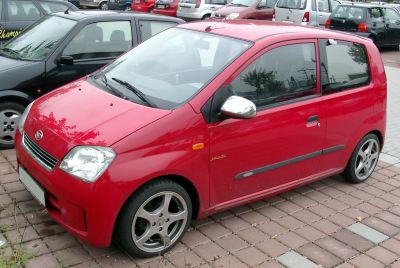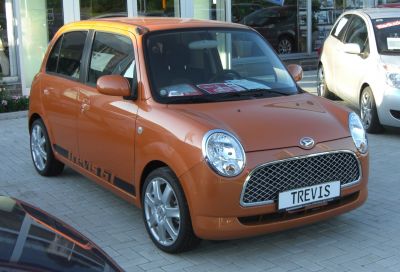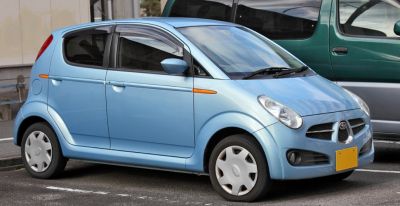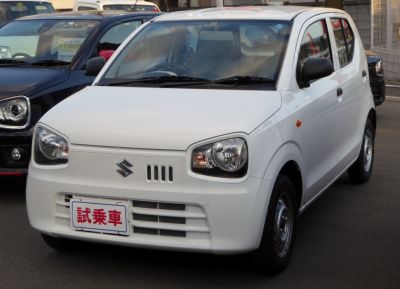 1998 Mitsubishi Minica VI Dimensions, Size & Specs
1998 Mitsubishi Minica VI Dimensions, Size & Specs
Measurements of the 1998 Mitsubishi Minica VI, engineered for optimal performance and comfort
| Dimensions | |
|---|---|
| Length: | 3395 mm133.7 in11.1 ft |
| Width: | 1475 mm58.1 in4.8 ft |
| Height: | 1510 mm59.4 in5.0 ft |
| Weight Specifications | |
| Curb Weight: | 690-750 kg1521-1653 lbs |
| Maximal permitted Weight: | 810-970 kg1786-2138 lbs |
| Tire Specifications | |
| Tire Size: |
|
The Mitsubishi Minica VI, produced between 1999 and 2007, is a compact hatchback designed primarily for urban driving and efficient space utilization. This generation of the Minica is notable for its compact dimensions, measuring 3395 mm (133.7 inches) in length, 1475 mm (58.1 inches) in width, and 1510 mm (59.4 inches) in height. These dimensions position the Minica VI firmly within the kei car category typical in Japan, catering to those requiring a small yet practical vehicle.
With a curb weight ranging from 690 to 750 kilograms (1,521 to 1,653 pounds), the Minica VI remains lightweight, contributing to its fuel efficiency and nimble handling characteristics. The maximum weight varies between 810 and 970 kilograms (1,786 to 2,138 pounds), allowing for passenger and cargo flexibility within its class. The tire specification is 135/80 R13, which balances ride comfort with effective road grip suitable for city environments.
The Mitsubishi Minica VI emphasizes efficient use of interior space despite its diminutive footprint, making it ideal for tight parking and maneuvering in congested cityscapes. Its height of 1510 mm provides a relatively spacious headroom for passengers, enhancing comfort without increasing the vehicle’s overall bulk.
This generation of the Minica reflects Mitsubishi’s approach to producing a practical, affordable, and easy-to-drive small hatchback that meets the needs of urban commuters and those looking for economical mobility solutions. Whether compared within the kei segment or to other small hatchbacks internationally, the Minica VI combines compactness with functional design, making it a notable choice for compact car enthusiasts and city drivers alike.
Discover the standout features that make the 1998 Mitsubishi Minica VI a leader in its class
Have a question? Please check our knowledgebase first.
The Mitsubishi Minica VI hatchback, produced between 1999 and 2007, is a compact kei car with precise dimensions tailored for urban driving. It measures 3395 mm (approximately 133.7 inches) in length, making it very compact and easy to maneuver in tight city spaces. The width stands at 1475 mm (about 58.1 inches), which supports a narrow profile suited for narrow roads and parking spaces typical in crowded urban areas. The vehicle's height is 1510 mm (around 59.4 inches), offering adequate headroom and a comfortable cabin height typical for its class. Together, these dimensions reflect the car's keenness on maximizing interior space while remaining extremely compact on the outside.
The Mitsubishi Minica VI features a curb weight ranging between 690 kg and 750 kg (approximately 1521 to 1653 lbs), which contributes to its agility and fuel efficiency. Depending on the specific model variant and optional equipment, this slight variance accommodates different trims and features. The maximum permissible weight, including passengers and cargo, ranges from 810 kg to 970 kg (about 1786 to 2138 lbs). This maximum weight rating means the Minica VI remains very lightweight compared to larger vehicles, which enhances its performance in city driving and ensures that it complies with kei car regulations in Japan.
Yes, the Mitsubishi Minica VI is well-suited for parking in standard residential garages. Standard garage dimensions typically range from about 2400 mm to 3000 mm wide (7.9 to 9.8 feet) and about 4800 mm to 6000 mm long (15.7 to 19.7 feet). Given the Minica VI’s compact length of 3395 mm (133.7 inches or about 11.1 feet) and width of 1475 mm (58.1 inches or roughly 4.8 feet), it fits comfortably within these typical garage dimensions. Its height of 1510 mm (59.4 inches or 4.95 feet) also poses no clearance issues for standard garage door heights, making it an ideal urban vehicle for owners with limited parking space.
Comparing the Mitsubishi Minica VI (1999-2007) to its predecessor, the Minica V generation, the VI generation maintains similar kei car compactness but with subtle updates aimed at better interior space utilization and styling. While specific dimensions of the predecessor are close, the Minica VI features refined exterior dimensions that slightly optimize length, width, and height for improved cabin comfort and aerodynamics. The Minica VI's length of 3395 mm and width of 1475 mm are generally consistent with previous models but present a more modern profile. Additionally, improvements in design allowed the Minica VI to be lighter and have better safety and efficiency, while retaining the practical city car footprint perfect for Japanese traffic and parking conditions.
When compared to other kei cars from the late 1990s and early 2000s, the Mitsubishi Minica VI fits right within the standard size regulations for this vehicle class, optimized for the Japanese market. Its length of 3395 mm, width of 1475 mm, and height of 1510 mm align with the typical kei car maximum exterior dimensions allowed in Japan, which are often capped near 3400 mm in length and 1480 mm in width. Competitors such as the Suzuki Alto and Daihatsu Mira of the same period have similar dimensional footprints, often differing by a few centimeters. Thus, the Minica VI's dimensions make it very competitive among peers regarding ease of use in dense urban environments, while offering comparable interior space and agility.
The Mitsubishi Minica VI is equipped with tires sized 135/80 R13. This means the tire width is 135 mm, the aspect ratio (sidewall height to width) is 80%, and the tires fit 13-inch diameter wheels. The relatively narrow tire width and high sidewall profile are characteristic of kei cars, providing a balance between ride comfort and handling on urban roads. The smaller 13-inch wheels help maintain lightness and responsiveness in steering, which is valuable for the Minica VI's intended city driving environment. The tire size also contributes to better fuel economy due to lower rolling resistance and improved maneuverability in tight spaces.
Despite its compact exterior dimensions dictated by kei car regulations—3395 mm length, 1475 mm width, and 1510 mm height—the Mitsubishi Minica VI is designed to maximize interior space efficiently. The tall height of 1510 mm aids in providing a spacious headroom for both front and rear passengers, making the cabin feel less cramped than the car's small footprint might suggest. Legroom and shoulder room for a vehicle of this size are modest but practical, optimized for short trips and city commutes. Seats are arranged to allow flexible configurations, often focusing on maximizing passenger comfort while meeting kei car standards for space and weight. Interior storage and ergonomics prioritize utility without compromising the lightweight, compact nature essential to this car class.
The Mitsubishi Minica VI’s curb weight ranges from approximately 690 to 750 kg (1521 to 1653 lbs), making it exceptionally lightweight among hatchbacks. This low weight directly benefits fuel efficiency, as the engine requires less power to propel the vehicle, resulting in lower fuel consumption and reduced emissions. The light curb weight also contributes to nimble handling and quick responsiveness, particularly useful in urban traffic where stop-and-go driving and tight maneuvering are common. Additionally, the decreased weight puts less strain on braking systems, enhancing overall vehicle safety performance. Overall, the Minica VI’s lightness is a key factor in maintaining its economical and practical appeal as a city car.
The Mitsubishi Minica VI typically accommodates four passengers comfortably within its compact dimensions, due to its hatchback design focusing on maximizing interior space. The rear bench seat allows for two passengers, while the front seats serve the driver and front passenger. Cargo capacity is modest, which is typical for kei cars of this class, designed primarily for short urban journeys. Rear seats can often be folded down to expand cargo space, enabling accommodation of larger items when necessary. However, the maximum permitted weight—including passengers and cargo—ranges from 810 kg to 970 kg (1786 to 2138 lbs), so owners should take care not to exceed this limit to maintain safe handling and performance.
Yes, during its production from 1999 to 2007, the Mitsubishi Minica VI was offered in several trim levels and engine variants to suit varying customer preferences and market demands. Trim levels often differed by features such as interior appointments, suspension tuning, and optional extras like air conditioning, power windows, and safety equipment. Engine options typically revolved around 3-cylinder gasoline engines adhering to kei car regulations for displacement (generally up to 660 cc), with slight tuning variations for fuel efficiency or modest power increases. Some versions also included four-wheel-drive (4WD) options, providing better traction in adverse weather or rural conditions. This variety made the Minica VI accessible to a broad range of customers looking for economical and versatile urban mobility.
Discover similar sized cars.

| Production: | 2003-2006 |
|---|---|
| Model Year: | 2003 |
| Length: | 3410 mm134.3 in |
| Width: | 1475 mm58.1 in |
| Height: | 1500 mm59.1 in |

| Production: | 2006-2009 |
|---|---|
| Model Year: | 2007 |
| Length: | 3400 mm133.9 in |
| Width: | 1475 mm58.1 in |
| Height: | 1500 mm59.1 in |

| Production: | 2002-2008 |
|---|---|
| Model Year: | 2002 |
| Length: | 3395 mm133.7 in |
| Width: | 1475 mm58.1 in |
| Height: | 1505-1515 mm59.3-59.6 in |

| Production: | 2003-2010 |
|---|---|
| Model Year: | 2004 |
| Length: | 3395 mm133.7 in |
| Width: | 1475 mm58.1 in |
| Height: | 1520 mm59.8 in |

| Production: | 2014-present |
|---|---|
| Model Year: | 2014 |
| Length: | 3395 mm133.7 in |
| Width: | 1475 mm58.1 in |
| Height: | 1475 mm58.1 in |

| Production: | 2016-present |
|---|---|
| Model Year: | 2016 |
| Length: | 3429 mm135.0 in |
| Width: | 1560 mm61.4 in |
| Height: | 1541 mm60.7 in |
